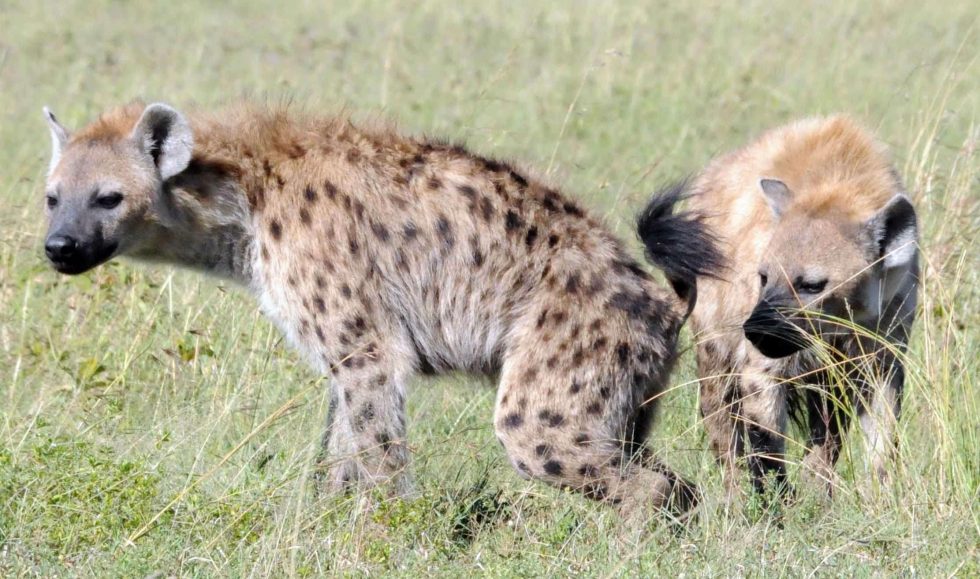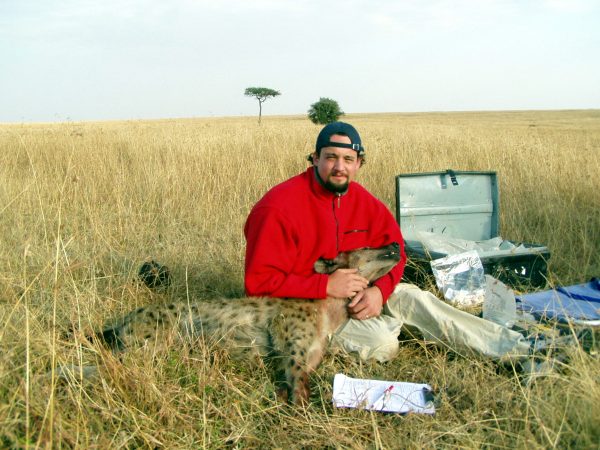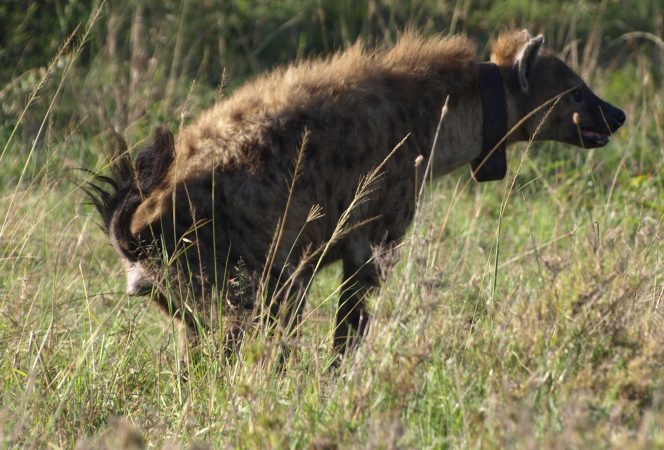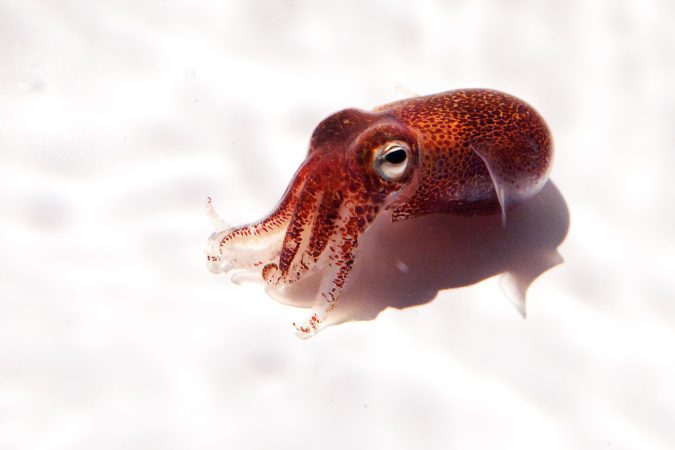Germs explain some animal behaviors
Tiny bacteria can have a big influence on how animals communicate and act, new research shows

A spotted hyena marks a stalk of grass with its unique scent, drawing a curious sniff. Scent plays an important role in how hyenas behave. New research reveals that bacteria influence behavior in these animals and others — possibly even people. 800x600
Courtesy of Michigan State University
The way hyenas smell is no laughing matter. Kevin Theis has been known to empty a laboratory of fellow scientists just by opening a bottle of what he calls “hyena butter.”
Hyenas secrete the pasty substance from a pouch tucked under their tails. This so-called butter is seriously stinky. It’s also crucial to how these African mammals communicate, explains Theis. An ecologist, he studies animal behavior and microbiology at Michigan State University in East Lansing. (Behavior is how an animal reacts to a particular situation or stimulus.)
Hyenas rub their pungent paste onto grass stalks — a practice called scent marking. The smell of that musky paste is something only another hyena could love. In fact, hyenas eagerly sniff the secretions to identify one another. Scents are one of the many ways animals are known to trade information. Indeed, odors can share a host of important data. What scientists are just beginning to realize is that when hyenas use scents to communicate, it’s bacteria that do most of the “talking.”

Theis found that bacteria living in the scent pouch of hyenas produce the chemicals that give the animals their particular smell. Hyenas rely on these unique scents to identify one another by species, sex and clan. That is important information. “A critical part of most animals’ behavior is an effective communication system,” Theis observes.
The big role that microbes play in how hyenas communicate isn’t unique. Scientists are learning that bacteria influence all types of behaviors seen in animals, including people. Here, we’ll learn about a small but growing group of scientists who have been exploring the ways bacteria can affect how animals communicate, act and even feel. Their research is as exciting as it is new.
Bacteria as “caller ID”
Animals are chock full of bacteria. In each of us, there are an estimated 10 single-celled microbes for every one of our own human cells. We’re outnumbered. But that’s a good thing.
People and other animals share a symbiotic relationship with many bacteria. We have evolved to help each other. We give bacteria a place to live and food to eat. In turn, the bacteria work hard on our behalf. Bacteria on our skin, for example, form a protective coating. It fights off the germs that can make us sick. Bacteria in the gut help digest food, releasing the energy and nutrients we need. These good bacteria also crowd out many bad bugs that can trigger disease.
Those things have been studied for decades. Far newer: the role microbes play in behavior.

Theis published a study in 2013 suggesting that among spotted hyenas in central East Africa, each animal’s paste contains a unique mix of odor-producing bacteria. At least in Kenya, the particular blend affected what an individual hyena’s paste smelled like.
Here’s why: Inside a hyena’s scent pouch, bacteria feed on nutrients. These probably include fats and proteins derived from what the animal ate. Just like people, those microbes don’t use everything they eat. Whatever doesn’t fuel a bacterium’s growth or reproduction will be expelled as waste. Some of those wastes are fatty materials that easily evaporate. They also make the paste stinky. Theis likens their smell to fermenting mulch.
Each spotted hyena has a different ratio of dozens of different bacteria in its scent pouch. That means each paste has a different recipe — and odor.
Our noses aren’t sensitive enough to pick up their subtle differences. Still, Theis can sort them out by identifying the bacteria responsible. He does this by analyzing the recipe of each bacterium’s DNA. Its building blocks appear in a very precise order — or sequence. It is so precise and unique to the bacterium that this genetic sequence is a bit like a fingerprint.
Identify the DNA sequence and you identify the bacterium. And when you identify the bacterium, you also identify the smelly waste it leaves behind.
Each spotted hyena seems to have its own mix of bacteria — and unique scent. A deep sniff of a pasted grass stalk can tell another hyena who marked it. And if it was a female, her scent also will signal whether she is pregnant or is nursing a cub.
Theis has watched hyenas sniff the paste left by others. The animals then behave in one way or another, depending on what they learned.
“Females spent much more time sniffing pastes from other females,” he says. This would “suggest that the scent of an alien female is very important.” And that makes sense, since females rule hyena clans. In contrast, the whiff of some alien male might not matter to her so much.
|
In this video, Elaine Hsiao discusses mind-altering bacteria and the role they may play in autism. Rob The Ranger Wildlife Videos/Youtube |
Still, Theis cautions, what increased sniffing time means is not totally clear. All hyenas in the wild, regardless of their age or gender, spent more time sniffing the pastes of pregnant females than of nursing ones. It’s not clear if that’s because pregnant females are more important or might just smell odd.
What’s clear, he says, is that without these bacteria, hyenas couldn’t share as much about themselves to others.
Theis and his colleagues reported their findings Dec. 3, 2013, in the Proceedings of the National Academy of Sciences.
Bacteria as cloaking aid
Symbiotic bacteria aren’t just found in land species. The Hawaiian bobtail squid hosts glowing bacteria in its ink sac. The squid is tiny — just 30 millimetres (1.2 inches) long, not counting its tentacles. It hunts in shallow coastal waters. And bacteria give this animal an advantage: camouflage.
“It’s like a Klingon cloaking device,” says biologist Margaret McFall-Ngai. She and her research partner, microbiologist Edward Ruby, have studied the roles played by this microbe and its squid host for 25 years. Both scientists work at the University of Wisconsin in Madison.
The bacteria, called Vibrio fischeri (VIH-bree-oh FISH-er-eye), live inside a special light organ in the squid’s ink sac. The microbes glow with the same intensity and color as moon and starlight. That glow masks the presence of the squid as it hunts by night. Without this camouflage, the tiny squid could end up a midnight snack for many fish. But thanks to the microbes, a predator gazing toward the water’s surface, where the squid feeds on small shrimp and worms, would see only what appears to be the lights of the moon and the stars, McFall-Ngai explains.
It’s little wonder, then, that newborn squid actively collect V. fischeri within seconds of hatching. The bacteria are found in the same areas as these squid. Squid scoop up the microbes with the help of two finger-like protrusions. They’re known as appendages. These appendages — don’t confuse them with tentacles — are located on their light organ, tucked inside the front of the squid’s body cavity.
Thousands of tiny, moving, hairlike features — cilia — cover those protrusions.

The squid makes a circle with its appendages. Their cilia sweep through the sea water with a waving motion. This directs V. fischeri toward three pores on the surface of a squid’s light organ.
Once the bacteria are inside, the squid can control the bacteria’s glow. In fact, the squid can even switch off their light. That way, the squid can mimic when a cloud blocks the light of the moon or stars.
The animal does this in two ways. One is by squeezing muscles in the ink sac to cover some of the glowing bacteria. The other is by controlling the amount of oxygen supplied to the microbes. The chemical reaction that makes the bacteria glow requires oxygen. The squid can constrict blood vessels leading to the light organ. That in turn reduces the availability of oxygen.
“These bacteria are small, but they are absolutely essential for proper behavioral function,” says McFall-Ngai. Using them for camouflage is a very clever adaptation to life near the sea surface, she points out, “where there is nowhere to hide.”
Bacteria: A role in autism?
One of the more surprising links between bacteria and behavior has emerged in studies of autism. This brain disorder makes it hard for people to interact and communicate with others. Research in mice by Elaine Hsiao is adding to the theory that changes in gut bacteria may underlie some autistic behaviors.
Hsiao is a neurobiologist at the California Institute of Technology, in Pasadena. She studies how the brain and nervous system function.
Studies had shown that people with autism are more likely to have too many or too few good bacteria in their gut. What’s more, the walls of their intestines also tend to leak. Wastes produced by those bacteria might leak out into the bloodstream. From there, they could quickly flow into the brain, the command center for behavior and mood.
But just because studies have found abnormal levels of gut bacteria in patients with autism doesn’t mean that microbes cause the disorder. To probe that, scientists are doing tests with mice. (There is no guarantee that mice and people will react the same way to changes in their gut bacteria. However, the bodies of both animals share many similarities. That makes the small animals a useful model in scientific studies.)
Certain mice actually show symptoms of autism. Like people with this disorder, they have both altered levels of gut bacteria and leaky guts, Hsiao found. So her team fed these mice applesauce laced with a human gut bacterium called Bacteroides fragilis (BAK-teh-ROY-dees FRAA-ji-lis) for three weeks. Afterward, levels of several species of gut bacteria returned to normal. The animals’ guts also leaked less.
More importantly, some autistic behaviors in the treated mice improved. And Hsiao’s team knows that because it measured three types of autistic behavior before that treatment began.
In one test, mice were placed in a box attached to two others. One box contained another mouse; the other a toy. Mice could choose to play with the toy or the mouse. Mice without symptoms of autism showed normal social behavior. They played with the mouse. Autistic mice, by contrast, preferred the toy.
A second test measured communication. Mice typically “speak” in an ultrasonic range, frequencies people can’t hear. Hsiao recorded their chatter with a special microphone that can pick up ultrasonic frequencies. Autistic mice “produced fewer calls and the calls were shorter,” she reports. In other words, they say less than normal mice do.
Finally, Hsiao placed mice in a bin containing wood shavings and a few marbles. In the wild, mice normally bury things. But the autistic mice kept burying the marbles. Then the mice dug them up and reburied them — over and over.
After eating the applesauce with B. fragilis, the autistic mice stopped compulsively burying marbles. They also communicated like normal mice. What didn’t change: They still preferred to play with toys, not other mice.
Hsiao and her colleagues published their findings Dec. 19, 2013, in the journal Cell.
How bacteria alter behaviors in these mice remains unknown. Hsiao says one theory is that bacterial wastes leaking into the blood might enter the brain, changing its chemistry. And chemical activities in the brain underlie many of our behaviors. Another theory: Gut bacteria somehow communicate with the brain over the vagus nerve. That long nerve runs between the gut lining and brain.
No matter how the change takes place, this study suggests “good bacteria” might help diminish autistic behaviors, says Hsiao.
Bacteria bug us, for better or for worse
There is much still to learn about how bacteria affect animal behavior. That’s one thing each of the researchers who was profiled here wants to emphasize. For example, how many bacteria are good? How many bacteria does it take to alter behavior? And precisely how might bacteria — or the chemicals they produce — trigger behavioral changes?
The research is all very new. As McFall-Ngai points out, scientists began to realize bacteria can affect behavior only in the last four to five years.
“It’s like all of a sudden a door has opened up,” she says. “Animal researchers are now looking at their studies and asking ‘Could what I’m seeing be influenced by bacteria?'”







